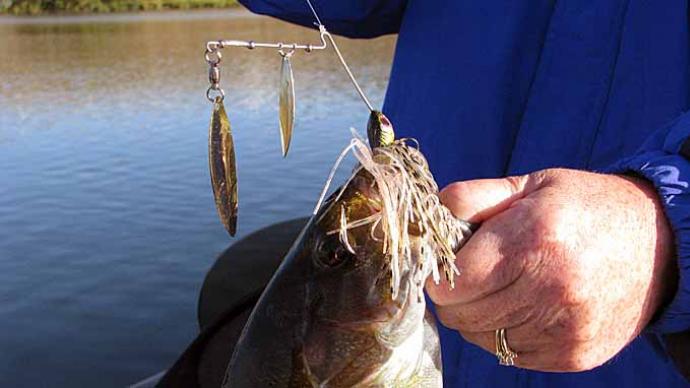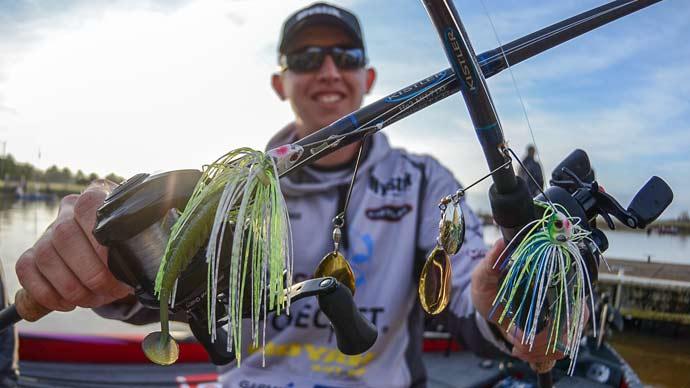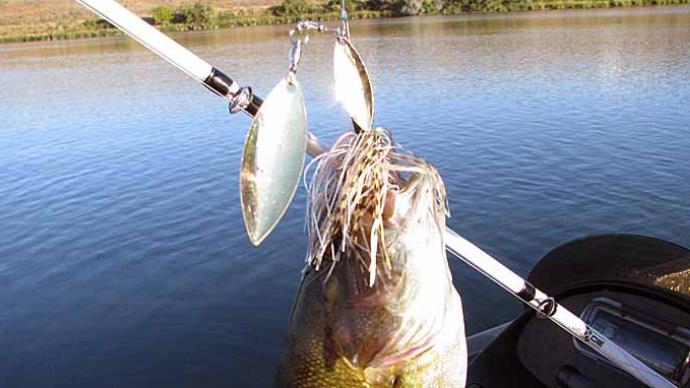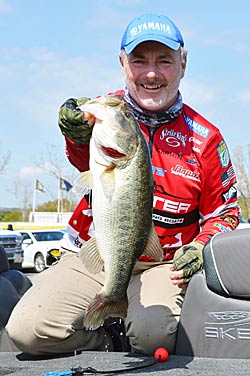
Bassmaster Elite Series angler Mark Menendez knows a thing or two about spinnerbaits. They met more than 40 years ago when he caught his first bass on one — double Colorado blades and a black-and-white skirt. Almost 20 years later, he used a 1/2-ounce spinnerbait with gold Colorado and willow-leaf blades to catch a 13-pound 9-ounce largemouth during the 1997 B.A.S.S. Megabucks tournament on Texas’ Richard Chambers Reservoir. It was the biggest bass ever to be weighed at any of the organization’s events, a record that stood for several years. Maybe, more importantly, it helped punch his ticket to his first Bassmaster Classic.
There was a time when spinnerbaits ruled bass fishing. Every angler worth their salt had one rigged and plenty of spares with different blade combinations and skirt colors ready in a tackle box. And many of the sport’s brightest stars were defined by them, whether Roland Martin was designing his Big Bass Spinnerbait — with your choice of a No. 5 or No. 7 willow-leaf blade — for Blue Fox Lures or Jimmy Houston flinging one around flooded bushes nearly every week on his cable-television show.
But times have changed. Over the past decades, spinnerbaits seemed to have lost their luster. They’ve received credit in fewer national tournaments, a tact that the weekend-fishing scene has mirrored. So, what happened? Bassmaster Elite Series angler Jay Yelas can point to several things. But even with those changes, he hasn’t shown spinnerbaits the door. They remain a tool for Menendez, too, though where, how, and when they fish them has changed.
What happened?
Spinnerbaits never disappeared altogether from the national bass tournament scene. They’ve seen a bit of a resurgence as of late. Current Major League Fishing angler Jason Christie fished a single-bladed one that weighed 1 ounce to a top finish at the 2016 Bassmaster Classic. Menendez used one for prespawn bass on his way to top-10 finishes at Elite Series stops on Alabama’s Lake Martin in 2018 and Florida’s St. John’s River in 2019, where the winner fished one, too. A few key catches at the 2019 Bassmaster Classic on Tennessee’s Fort Loudoun and Tellico lakes came on spinnerbaits. Those instances have one thing in common: opportunity.
Yelas said a lack of opportunities is why spinnerbaits have seemed to fall from favor among pros. Often, these anglers compete in clear-water fisheries, where a spinnerbait’s bulk, flash, and vibration turn off bass. And those that regularly see high levels of fishing pressure have the same reaction to spinnerbaits.
The days of dropping the trolling motor and moving down a bank, flinging a spinnerbait at whatever cover you come across, are gone, said Menendez. That’s now done with a square-bill crankbait or bladed jig such as Strike King’s Thunder Cricket. He said vibrating jigs draw bites in muddy and wavy waters, where spinnerbaits work best and when conditions are clear and calm. Lures that work that well quickly become favorites. “We are models of repetition,” he said. “We find new lures [that work], and we forget about others.”
Vibrating jigs aren’t the only lure that’s taken work from spinnerbaits. Yelas said swimbaits catch plenty of bass, especially in clear water. Their slim profile and thumping tail closely mimic baitfish. They come in various colors, including translucent ones that create an illusion that curious bass have to bite to investigate. And with plenty of sizes to choose from, Menendez said there are large ones that attract big bass and smaller ones that quickly fill limits.
Situation specific
Modern-day spinnerbait fishing is about extremes for Menendez. He’s ripping one just under the surface or slow-rolling one around isolated pieces of cover and structure. Those retrieves let spinnerbaits’ best traits shine. And either way, he said, their hook-to-land ratio remains one of the best among all lures.
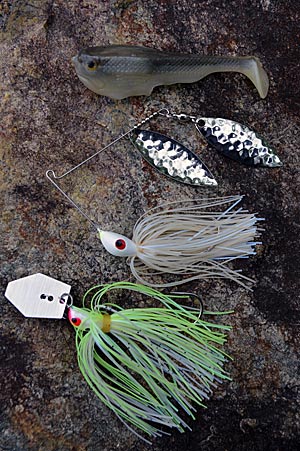
Yelas said spinnerbaits catch the most bass from warming water stained to muddy. Bass are willing to chase under those conditions, he said, plus the water color disguises a spinnerbait, forcing curious bass, which can’t see it well, to strike. Those conditions are most often found in the spring when bass are prespawn.
Spring also brings the shad spawn, which usually starts as bass spawning winds down. Yelas said it also is primetime for spinnerbaits, which are easy to fish around the shallow cover — rip-rap, docks, aquatic vegetation, and overhanging tree limbs that dip into the water — where shad spawn. It’s a pattern that fires strongest at first and last light, so off-colored water isn’t required. And if you squint your eyes, a spinnerbait, with its two blades and skirted body, resembles a small school of shad moving through the water.
Menendez said one condition is non-negotiable when it comes to spinnerbait fishing. “If you have wind, you have a great spinnerbait bite,” he said. It ripples the surface, reducing the light that shines through, creating a similar effect to stained water. He said wind makes spinnerbaits an option in clear water, even on Great Lakes fisheries, where the bottom is visible in 20 or more feet of water under a high sun in a bluebird sky.
Same spinnerbait — almost
Yelas said today’s spinnerbaits are the same as those fished decades ago. They’re still of the “safety-pin” design with one, two, or sometimes a handful of blades. They nearly always consist of a combination of hard-thumping Colorado blades, which lift spinnerbaits toward the surface; Indiana, which combines thump and flash; and willow leaf, which offer the most flash but the least lift. They rotate around a wire that connects to a weighted head and skirt-covered hook below.
A spinnerbait blade’s vibration is deadened or amplified by the diameter of its wire. Spinnerbaits with thinner wire, which Yelas prefers, put off more bass calling vibration than spinnerbaits with thicker wire. Menendez put that truth to work at the 2019 Bassmaster Elite Series stop at Winyah Bay in South Carolina. He fished a 1/2-ounce Strike King Compact Silhouette Spinnerbait, whose wire frame is as small as the ones used on 1/4-ounce spinnerbaits. That helped its No. 2 and No. 4 Colorado blades create more vibration in the murky tidal water.
While thin-wire spinnerbaits have benefits, you must weigh the risk of fishing them. Wire diameter determines longevity. Thin-wired models, for example, easily bend during battles with bass, especially hard-hitting and high-jumping smallmouth. Often you can straighten the wire with your hands and catch a few more smallies. But eventually, the wire will break. And hopefully, that doesn’t happen while you are hooked up with the day’s biggest bass.
Yelas said one spinnerbait advancement was pushed by legendary Bassmaster Elite Series angler Rick Clunn. He designed the Trickster Spinnerbait. It features long drop blades, which resemble stretched Indiana-style blades. They keep the trademark thump while adding flash like a willow-leaf blade. It has produced plenty of bass since its release, but the biggest splash came at the Bassmaster Elite Series stop on Florida’s St. Johns River in February 2019. Clunn fished a Trickster around bass beds to imitate bream. It was one of three lures he used to catch 98 pounds and 14 ounces and win the four-day tournament.
Menendez finished third at that St. Johns tournament, thanks partly to a 3/8-ounce spinnerbait. It featured Colorado and willow-leaf blades, a small piece of chartreuse worm threaded on the hook as an attractor, and a black skirt with a few strands of purple. Black skirts were a favorite of his years ago, and he finds himself using them again, giving bass something other than the usual white and chartreuse. One skirt color he never stopped using is cantaloupe or Elroy — a dark mustard with a few strands of red. He used it to catch his Megabucks giant and finish in the top 10 at Lake Martin in 2018.
Menendez makes his spinnerbaits appear larger by adding a 6-inch ribbon-tail worm as a trailer. He said that gives it a profile similar to a gizzard shad, which attracts larger bass. One spinnerbait trailer that more bass anglers are using is a small swimbait. Its tail creates more action than the more traditional curly tail grubs or slender split-tail trailers.
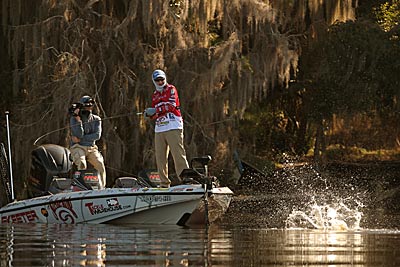
Spinnerbaits still need trailer hooks, especially when you’re ripping one along. Menendez said bass can only slash at one at that speed. “They don’t get a good bullseye on it,” he said. He estimates that at least 60 percent of the bass he lands on a spinnerbait are caught by the trailer hook.
Menendez uses Gamakatsu trailer hooks. Their shanks are longer than most, making it easier to connect with a bass. He uses two sizes: 1/4-ounce or lighter spinnerbaits are outfitted with a 1/0 model, and all heavier spinnerbaits get a 2/0 model.
Menendez wants his trailer hook to swing free so it stays tucked behind his spinnerbait’s body and safe from snags. He slides his trailer hook over his main hook, then uses a Rapid Fishing Solutions Hook All tool to slide one of its small plastic discs over the main hook. It allows the hook to move from side to side but not slide off the hook.
New tools
From competitive bass fishing’s early days through the first years of two-handed rods, the one-handed pistol grip rod was the standard for tossing spinnerbaits. But as spinnerbaits and how they’re fished have changed, so have the rods, reels, and line used to throw them. Menendez has assembled different outfits for burning and slow-rolling spinnerbaits.
Slow-rolled spinnerbaits typically have heavy heads — 3/4 ounce or more — and willow-leaf blades. Menendez keeps them slowly churning along the bottom with a Lew’s BB1 reel. It has a slow 5.1:1 gear ratio, which brings in only 21 inches of line per handle turn. He matches it to a 6-foot, 10-inch Lew’s rod. Its relatively shorter length cuts his ability to lift the spinnerbait, and he uses a sideways pull like he is sliding a Carolina rig along the bottom.
Menendez spools his reel with Seaguar AbrazX. The fluorocarbon line is abrasion resistant and strong. He picks its pound test based on water color and cover density, going stronger as they get dirtier and heavier.
Fluorocarbon, with almost no stretch, transmits strikes well. It lets Menendez react sooner, which can pull lures away from biting bass, especially when burning spinnerbaits through open water. So, he slows down with a medium-heavy Lew’s David Fritts Perfect Crankbait rod that measures 7 1/2 feet. While he reacts to a strike just as quickly, the rod’s slower action takes time to load, giving bass time to grab his spinnerbait. He mounts a Team Lew’s Lite reel with a fast 7.5:1 gear ratio, which sucks in 33 inches of line with each handle turn to the rod.
If Menendez is burning spinnerbaits around shallow cover, he matches the same reel to a 7-foot 3-inch Lew’s Custom Speed Stick Football Jig Rod. He said it’s perfect for accurately casting spinnerbaits from 1/4 to 1 ounce.
BassResource may receive a portion of revenues if you make a purchase using a link above.


